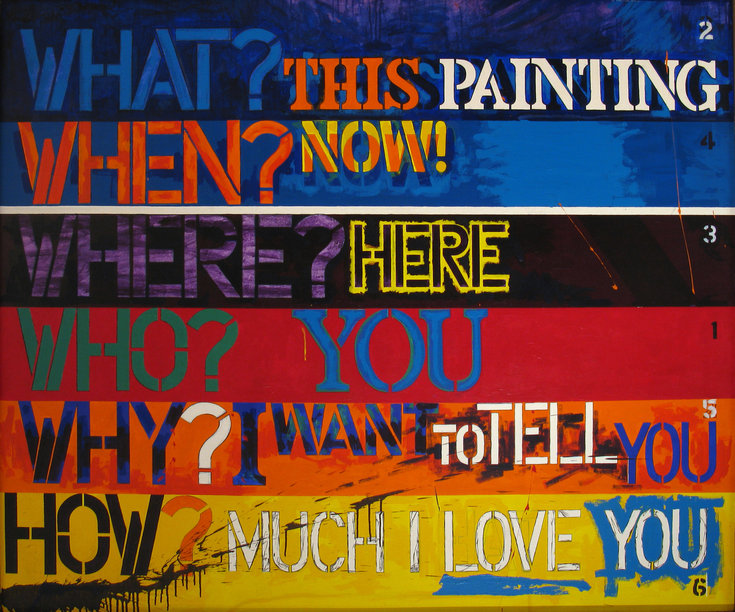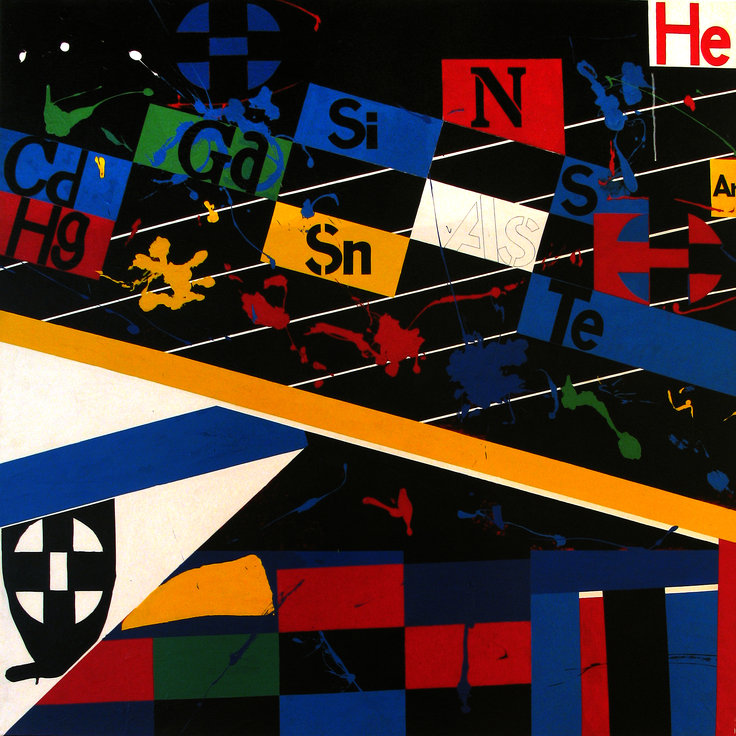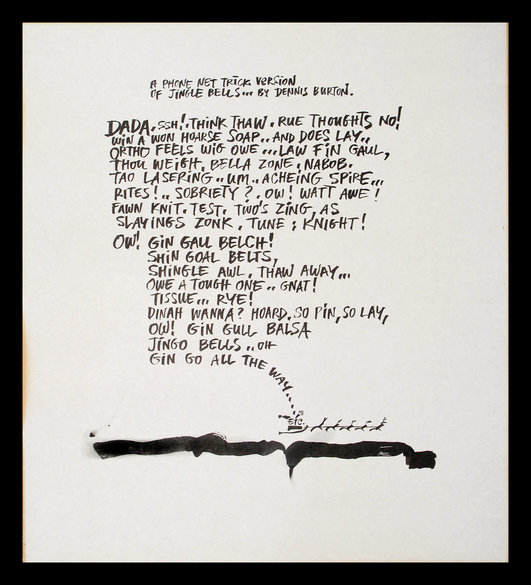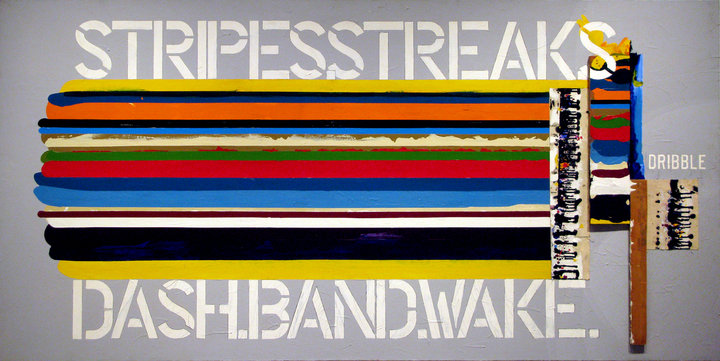By Ashley Johnson
 Six Questions, 1976, acrylic on canvas, 60 x 72 inches. Courtesy of Christopher Cutts Gallery
Six Questions, 1976, acrylic on canvas, 60 x 72 inches. Courtesy of Christopher Cutts Gallery
An exhibition in conjunction with THIS IS PARADISE, Mocca, 2011
Christopher Cutts Gallery,
June 25 – August 31, 2011
A sign of cultural maturity in developed societies is the wholehearted support and celebration of its artists. Their contribution is recognized as ‘cultural capital’, to be nurtured and exported, whether as art objects or social ideas. Value is attached and upheld by institutions that generate knowledge and shows about that product. A case in point is the current Abstract Expressionist exhibition at the AGO, orchestrated by MOMA (NY).
THIS IS PARADISE seeks to re-present the 80’s art scene in Queen Street West and is linked to Dennis Burton’s show, ‘Word Magic’ at the Christopher Cutts Gallery, because Burton taught some of the artists in the 60’s and 70’s at The New School of Art and Art’s Sake. That said, it’s an extremely tenuous connection artistically because the artists in THIS IS PARADISE represent mainly figuration, exemplified by the group Chromazone, whereas Burton’s art and teaching runs the gamut of modernism. A cursory glance at Burton’s extraordinary contribution both as an artist and as an educator makes one wonder why the institutional acknowledgement of these decades is so understated. The conjunction highlights the immaturity of this society.
 Alchemy, 1978, acrylic on canvas, 60 x 60 inches. Courtesy of Christopher Cutts Gallery
Alchemy, 1978, acrylic on canvas, 60 x 60 inches. Courtesy of Christopher Cutts Gallery
Burton uses words like a mechanic greasing an axle, fluidly and with some abandon. They lose their form and meaning, becoming sound poems generating new meanings through chance juxtapositions. Duchamp is ‘in the room’. There is an innate beauty to Burton’s writing style, which oscillates between making shapes out of words to laboriously etching text into every available space on the page. He loves words sensuously.
 Jingle bells circa 1965, on paper, 18 x 16 inches
Jingle bells circa 1965, on paper, 18 x 16 inches
Courtesy of Christopher Cutts Gallery
There are some very absorbing framed texts in which Burton answers questions put by Rae Johnson and Brian Burnett about his experiences after graduating from OCA. It’s astounding to learn that the fine-arts program was abandoned by OCA in 1956 in favour of design elements. This galvanized Burton and his colleagues in 1965 to begin teaching art at The New School of Art and later Art’s Sake. There is something heroic in Burton’s efforts to survive monetarily and still teach students to become practicing artists. He is apparently remembered for his erudite lectures that synthesized knowledge from all spheres. Uniquely, his colleagues included artists actively working at their profession like Gordon Rayner, Robert Markle and others who all achieved some local notoriety. The schools sound like hotbeds of creativity and fun, with the Artist’s Jazz Band performing alongside theatre events. There are taverns like the Cameron House that became cultural meeting places. The roles of galleries such as Av Isaacs and Dorothy Cameron are mentioned. Censorship rears its head when police confiscate works and the artists go on trial but charges are later dismissed. In this period Burton made erotic images of women in a series called Garterbeltmania. They seem quite inoffensive and rather beautiful now.
 Stripe Streak, 1977, acrylic on canvas, 49 x 98 inches. Courtesy of Christopher Cutts Gallery
Stripe Streak, 1977, acrylic on canvas, 49 x 98 inches. Courtesy of Christopher Cutts Gallery
The paintings in this show remind me of Robert Rauschenberg and Jasper Johns’ work except Burton’s are more text based. They share an anomalous position in my mind as not quite ‘Pop Art’ yet vital in their Dadaistic ‘clawing back’ meaning from the excesses of Abstract Expressionist theory. Burton’s words have a humanity that reaches out, as in his painting Six Questions, which ends in an expression of love for … perhaps the viewer. In Stripe Streak he plays with meaning and action ironically. The self-importance of post painterly abstraction is gently and humorously debunked.
Glancing at Burton’s timeline on the ccca.ca website, one is left wishing to see a more comprehensive retrospective of the era and his art. It would be a pity if this history just lapses into obscurity. Fifty-odd years have already passed so it’s about time!

Hello Ashley,
Thank you for this. Its time to honour the artists who struggled before us and gave us the gift of their work and inspiration. The New School was like finding my true home, and although my work does not look like my teachers work, their courage and honesty and spirit have always informed my own teaching and how i proceed with my own work.
Thank you!
Rae Johnson
Thank you Ashley
You have written a very insightful piece on Dennis Burton’s works in this exhibition at Chris Cutts Gallery, and have definitely picked up on his key references. Dadaism and Duchamp, Jasper Johns,as well as Robert Motherwell and Dekooning and Rauchenberg were artists with whom he felt a strong connection, while pursuing his own unigue directions.
His legendary”Burtonese” manipulation of language exemplified his life long fascination with the nature of communication. As an artist who taught at the New School of Art and Arts’Sake Inc. and currently at OCAD and as a long time colleague of Dennis Burton, I witnessed and experienced the passion that we, Dennis and myself, and Gordon Rayner, Graham Coughtry, and Robert Markle and all our colleagues had for making art and for passing that passion on to the next generation of artists. There was an urgency that we all felt at that time,- that we had to make certain that the younger artists we taught would have the freedom to engage their artistic and aesthetic expression with love for their materials craft and concepts; with intensity, integrity, creative thought, commitment and abandon. And have a great time doing it!!